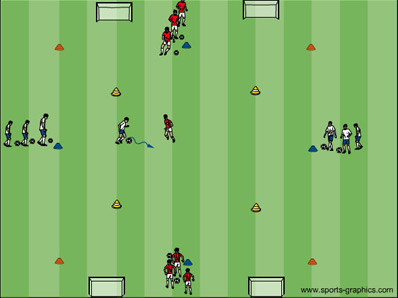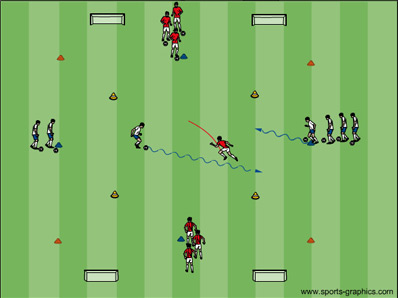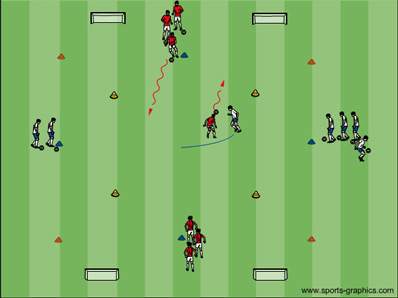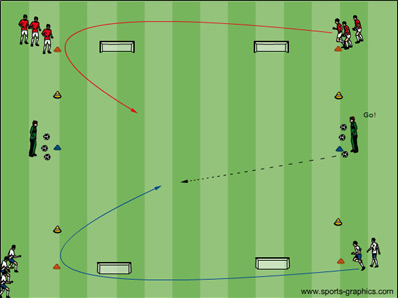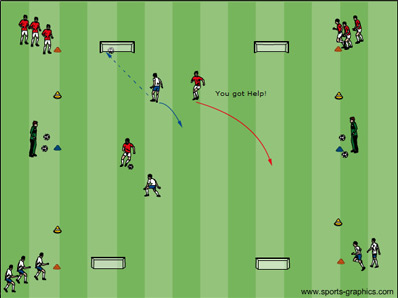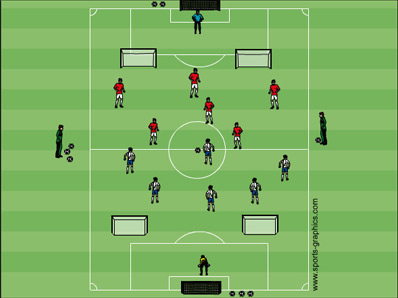A few years back I had the opportunity to observe former US Men’s National Team Coach, Bruce Arena, run a field session at The Soccer Champions Workshop in CT. I’ve long since forgotten the exercises Coach Arena ran, but he made a comment that has stuck with me to this day. A coach, no matter what their level, can create the proper environment for a successful practice if they control the things within their control.
According to Coach Arena there are four things all coaches should take into account prior to practice:
- Understand the level of your players. Try not to plan a sessions they are incapable of carrying out.
- How many players will I have today? You don’t need to be a soccer expert to be organized.
- How’s the surface? If you’re practicing at Adams you can’t do some of the things you can do at Lincoln.
- Equipment Available. Do I have a goal today? Enough discs and pinnies, etc.
I’ve found taking Coach Arena’s advice has been helpful in not only my own growth as a coach, but also my players’ development and enjoyment of the game. I’d recommend that all coaches give these four points consideration when preparing their practices, but I’d also add fifth point to follow upon arriving at the field.
Get Set Up! The Set-up IS important. The number one thing I look for when I observe a training session is the pace of the practice. The better the initial set-up, the better the flow and the better flow, the more engaged the players are. The more engaged your players are, the more they enjoy the training and the better they develop. Virtually all problems I witness when running my own or observing others practices arise out of boredom (long lines, too much time between activities, lengthy instruction, etc). The antidote to these practice problems is a proper set-up.
If one arrives at the field and gets their set up correct, he or she can run their entire practice with little to no changes from start to finish.
This simple set-up will allow one to run a:
- German Box Warm-up
- 1v1 Pressure Training Exercise
- Fast Break Attack Exercise
- Short Goal, Far Goal Game
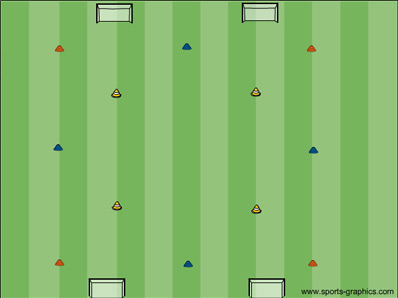
Warm-Up: The German Box
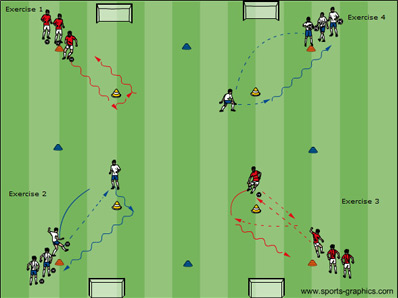
Exercise 1: Dribble in, in a controlled manner, around the disc without touching it, and accelerate back to your line. Once the first player begins to accelerate back, the next player in line dribbles in to the middle.
Note: Coach should designate which side the players dribble toward the disc from, lessons the chance of collisions with teammates.
Exercise 2: A player stands,”on his/her toes” without a ball, about 2 yards past the inner disc. The first player in line passes the ball to the player in the middle, the player in the middle touches the ball behind the disc to the other side the space” and accelerates back to the line. The player that passed the ball now runs into thmiddle and assumes the position of the middle player.
Exercise 3: A player stands, “on his/her toes” without a ball, about 2 yards past the inner disc. The first player in line passes the ball to the player in the middle, the player in the middle passes the ball back to his/her teammate and moves behind the disc for a return pass. Once receiving the “wall pass” he/she should accelerates back to the line. The player that combined with their teammate now runs into the middle and assumes the position of the middle player.
Exercise 4: Same as exercise #2, but the ball is tossed underhanded to the player at the disc forcing them to receive.
1st Activity- 1v1 Pressure Training
The Set-up: All players now move to the blue discs. Red players (split into two lines) facing one another, white players do the same. All players in line should have a ball. One red player begins in the box without a ball to serve as the defender.
Note: You can only defend in the box.
The Exercise: The first white player dribbles into the box to “take the red player on” and attempts to dribble out the other side of the box. Red attempts to win the ball and dribble out of the box to either side his/ her teammates are on.
Once the white attacker dribbles the box, the first white player in the line his teammate dribbled immediately begins to attack in the opposite direction. The Red player MUST immediately transition to defend the new attacker in an effort to prevent him from dribbling the opposite line.
When Red wins the ball and dribbles out of the box to either side his or her teammates are on, the white attacker who lost the ball now remains as the defender and the first red attacker from the line that the red defender dribbled begins to attack.
Coach should enforce the boundaries. If the attacker dribbles “out of bounds” he/she becomes the defender. Also don’t allow the players in line to creep forward.The gap from the end-line to the disc the defender a chance to transition and defend the next attacker.
Focus:
- 1v1 Attacking
- 1v1 Defending
- Transition
- Commitment
2nd Activity: Fast Break Attack 1v1 (becomes 2v2) to 4 Goals with Lateral Sprint
Set-up Adjustments:
Move the orange discs down to be in line with the pugg goals.
Move the yellow discs in line with the orange and blue discs to form a sideline and shooting zone. The yellow discs should be approximately 6 yards from the end-line.
The Game: When the coach yells Go! The 2 players closest to him, sprint behind the far goals and onto the field. The coach should play the ball out to the player quickest onto the field. A game of 1v1 ensues. The white player tries to dribble into the shooting zone and score in either of the two goals defended by the red. If Red wins the ball he/she should attack the white’s goals. Once a goal is scored or the ball goes out of bounds, the other coach yells Go! And the same movements occur from the other side.
Focus:
- Quick Sprint
- Taking a player on
- Acceleration
- 1v1 Defending
1st Progression: When one coach yells Go! The first 4 players sprint behind the goals, need to avoid running into each other, and onto the field. Each coach should play the ball out to the player who is quickest entering the field behind the goals closest to them (this will prevent the same player from getting both balls played to him).
Two games of 1v1 ensue.
Note: Players can score in either of the goals being defended by the opposite color.
This progression creates higher levels of repetition and forces players to have a better sense of their surroundings (heads up to avoid collisions).
Final Progression: When the first 1v1 concludes with a goal or the ball going out of bounds, these two players should move quickly to support the ball that is still in play. This will create a 2v2 situation.
Variation: The first goal scorer is done. This will create a 2v1 in favor of the team that conceded the initial goal.
Point System:
1 point for goals scored in the 1v1
2 bonus points for a goal scored in the 2v2
Focus: 1v1 Attacking, 1v1 Defending, Transition, 2v1 with Recovery, 2v2, Fitness
Game Segment: Short Goal, Far Goal
Set-up Adjustments:
None to the initial layout, but there are now two large goals approximately 15 yards behind the original field.
The Exercise: It is a normal scrimmage, but with the option to either attack the short goals (the puggs) or the long goal. Coach can add a restriction that doesn’t allow the defending team to drop deeper than the near goal until the ball is played in behind. The off-side rule should be in effect.
Note: If you use larger goals, each team should have one goalie that would be responsible for helping defend all of their teams’ goals.
Focus:
- When to attack the space behind the near goals?
- When to attack the near goals?
- When to keep possession and re-circulate your attack?* If you initially attack the large goal and the defense recovers, can you bring the ball back (re-circulate your attack) and score in the puggs?
In Conclusion: Selection of practice activities is a huge component of coaching and preparing a team properly. Once a coach identifies areas that their team needs to address, the selection of activities to address these needs comes into play. Not only should a coach choose exercises that are developmentally appropriate and on topic, the exercises should flow together (simple to
complex) to create a proper pace to the practice which will maximize the players learning and enjoyment. Limiting the amount of down time due to changes in the practice set-up is an often overlooked piece of the puzzle, but once it is in place the quality of practice time with one’s players will be enhanced dramatically. The Set up IS important and is something we, as coaches, can control. Enjoy your coaching!
